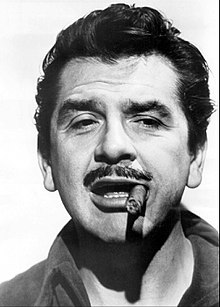
Nome is a city in the Nome Census Area in the Unorganized Borough of Alaska, United States. The city is located on the southern Seward Peninsula coast on Norton Sound of the Bering Sea. It had a population of 3,699 recorded in the 2020 census, up from 3,598 in 2010. Nome was incorporated on April 9, 1901, and was once the most-populous city in Alaska. Nome lies within the region of the Bering Straits Native Corporation, which is headquartered in Nome.

True Grit is a 1969 American Western film directed by Henry Hathaway, starring John Wayne as U.S. Marshal Rooster Cogburn, Glen Campbell as La Boeuf and Kim Darby as Mattie Ross. It is the first film adaptation of Charles Portis' 1968 novel of the same name. The screenplay was written by Marguerite Roberts. Wayne won an Oscar for his performance in the film and reprised his character for the 1975 sequel Rooster Cogburn.

Fabian Anthony Forte, professionally known as Fabian, is an American singer and actor.

Capucine was a French fashion model and actress known for her comedic roles in The Pink Panther (1963) and What's New Pussycat? (1965). She appeared in 36 films and 17 television productions between 1948 and 1990.

Francis Thomas Avallone , better known as Frankie Avalon, is an American actor, singer, and former teen idol. He had 31 charting U.S. Billboard singles from 1958 to late 1962, including number one hits, "Venus" and "Why" in 1959. He is the earliest surviving singer to have scored a solo #1 hit on the Billboard Hot 100.

Stewart Granger was a British film actor, mainly associated with heroic and romantic leading roles. He was a popular leading man from the 1940s to the early 1960s, rising to fame through his appearances in the Gainsborough melodramas.

John LaGale Horton was an American country, honky tonk and rockabilly musician during the 1950s. He is best known for a series of history-inspired narrative country saga songs that became international hits. His 1959 single "The Battle of New Orleans" was awarded the 1960 Grammy Award for Best Country & Western Recording. The song was awarded the Grammy Hall of Fame Award and in 2001 ranked No. 333 of the Recording Industry Association of America's "Songs of the Century". His first No. 1 country song was in 1959, "When It's Springtime in Alaska ".

Richard Owen Fleischer was an American film director whose career spanned more than four decades, beginning at the height of the Golden Age of Hollywood and lasting through the American New Wave.

The Alamo is a 1960 American epic historical war film about the 1836 Battle of the Alamo produced and directed by John Wayne and starring Wayne as Davy Crockett. The film also co-stars Richard Widmark as Jim Bowie and Laurence Harvey as William B. Travis, and features Frankie Avalon, Patrick Wayne, Linda Cristal, Joan O'Brien, Chill Wills, Joseph Calleia, Ken Curtis, Ruben Padilla as Santa Anna, and Richard Boone as Sam Houston. Shot in 70 mm Todd-AO by William H. Clothier, it was released by United Artists.

Henry Hathaway was an American film director and producer. He is best known as a director of Westerns, especially starring Randolph Scott and John Wayne. He directed Gary Cooper in seven films.
Charles K. Feldman was a Hollywood attorney, film producer and talent agent who founded the Famous Artists talent agency. According to one obituary, Feldman disdained publicity. "Feldman was an enigma to Hollywood. No one knew what he was up to – from producing a film to packaging one for someone else."

The Spoilers is a 1955 American Western film directed by Jesse Hibbs and starring Anne Baxter, Jeff Chandler and Rory Calhoun. Set in Nome, Alaska during the 1898 Gold Rush, it culminates in a spectacular saloon fistfight between Glennister (Chandler) and McNamara (Calhoun).
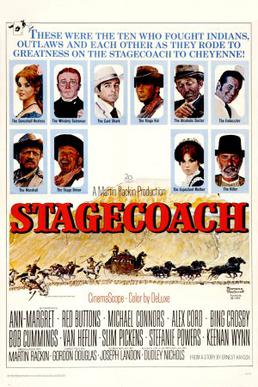
Stagecoach is a 1966 American Western film, directed by Gordon Douglas between July and September 1965, as a color remake of the Academy Award-winning John Ford 1939 classic black-and-white western Stagecoach. Unlike the original version which listed its ten leading players in order of importance, the major stars are billed in alphabetical order.

Wendell Curran Mayes was a Hollywood screenwriter.
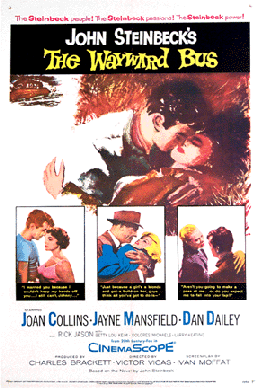
The Wayward Bus is a 1957 American drama film directed by Victor Vicas and starring Joan Collins, Jayne Mansfield, Dan Dailey and Rick Jason. Released by 20th Century-Fox, the film was based on the 1947 novel of the same name by John Steinbeck.
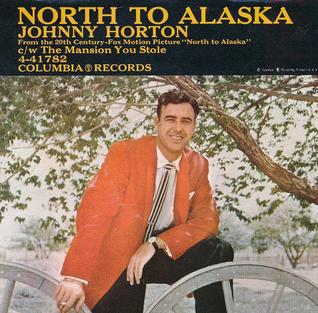
"North to Alaska" is a 1960 hit song recorded by Johnny Horton that was featured in the movie of the same name. The song was written by Mike Phillips, along with Tillman Franks. Though Horton had sung several popular movie tie-in songs, this was the first one that was sung over the opening titles. Horton died in an automobile accident November 5, 1960 two days before the movie was released. Members of the Western Writers of America chose it as one of the Top 100 Western songs of all time.
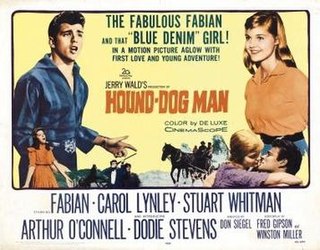
Hound-Dog Man is a 1959 American musical comedy drama film directed by Don Siegel, based on the 1947 novel by Fred Gipson, and starring Fabian, Carol Lynley, and Stuart Whitman.

The Nome Gold Rush was a gold rush in Nome, Alaska, approximately 1899–1909. It is separated from other gold rushes by the ease with which gold could be obtained. Much of the gold was lying in the beach sand of the landing place and could be recovered without any need for a claim. Nome was a sea port without a harbor, and the biggest town in Alaska.
Martin Rackin was an American writer and producer who was briefly head of production at Paramount Pictures from 1960 to 1964. In the late 1950s he wrote and produced a series of films with actor Alan Ladd.

The Wizard of Baghdad is a 1960 American comedy/fantasy film directed by George Sherman and starring Dick Shawn, Diane Baker, and Barry Coe. It was released by 20th Century Fox.

